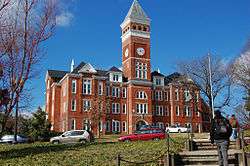Tillman Hall at Clemson University
| Tillman Hall | |
|---|---|
 Tillman Hall in 2008 | |
| Former names | Main Building |
| General information | |
| Address | Clemson, University |
| Opened | 1893 |
| Design and construction | |
| Architecture firm | Bruce & Morgan |
Tillman Hall is the most famous building on the Clemson University campus. The 3 story brick building with a clock tower is located on a hill overlooking Bowman Field. Tillman Hall is currently the home of the College of Education.
Connected to Tillman Hall is the Tillman Auditorium, a 755-seat auditorium that formerly was a campus chapel named Memorial Chapel. Tillman Auditorium is used primarily for lectures and seminars, small concerts, pageants and dances.[1]
Tillman Hall at Clemson University and Tillman Hall at Winthrop University are both named after former South Carolina governor Benjamin Tillman. He played a large role in the founding of both universities.
History
Tillman Hall was nationally registered as part of Clemson University Historic District I. It is one of the few remaining buildings from Clemson University's original campus.
Tillman Hall was designed by Bruce and Morgan, who also designed several other famous college buildings in the south to include Samford Hall at Auburn University and Tech Tower at Georgia Tech. The building was built in 1893 using the labor of convicts. A fire destroyed all but the exterior walls in 1894. Bruce and Morgan oversaw the subsequent renovation that was completed in 1895. Tillman Hall was originally called the Main Building or Agricultural Hall. The building featured the first library, many classrooms and laboratories, and a chapel.[2]
The original clock in Tillman Hall was built by the Seth Thomas Clock Company and installed in 1906. The clock tower was modernized in 1985, and the old clock was placed into storage. The Western Carolina Chapter of the National Association of Watch and Clock Collectors (NAWCC) became aware of the existence of the old clock in 2005 and worked with members of Clemson's College of Engineering to restore it. The old Tillman tower clock is on display in the Fluor Daniel Building on campus.[3]
Clemson Memorial Carillon
Located in the top of Tillman Hall's clock tower is a 48 bell traditional carillon.
The carillon was installed in 1987. A 47 bell carillon replaced a single untuned bell, now hanging in Carillon Garden by Sikes Hall, that rang across campus during Clemson's days as a military school. The bells range in weight from 4,386 pounds to 32 pounds.[4] The 48th bell was installed in 2012. The Undergraduate Student Senate voted to allocate $63,000 for a 2,800-pound D#/E flat 3 bell needed to complete the instrument.[5]
Clemson Memorial Carillon is one of only 66 traditional carillons located at universities in North America.[6]
The carillon is configured for the automatic playing of the Westminster chimes every 15 minutes or other music using traditional baton claviers.[7]
The University Carillonneur plays the carillon every Monday, Wednesday, and Friday noon-12:30pm, August–April. Visitors are welcomed into the Tillman Hall tower to watch these performances. Students can take classes to learn how to play.[8]
Thomas Clemson Statue
There is a bronze statue on the front side of Tillman Hall. The statue is nicknamed "Old Green Tom", which refers to the weathered down figure of Clemson University's founder, Thomas Green Clemson.[9]
Current events
Due to Benjamin Tillman's politics, actions, and stance regarding racial relations, the naming of the building currently known as Tillman Hall has come under scrutiny in recent years, particularly during the 2014–2015 academic year. In fact, Tillman was an ardent racist. In July 1876, he led a group of white supremacists, who called themselves the Red Shirts, into Hamburg, South Carolina to kill six African-American men and murder four others whom the group had captured. This massacre propelled him to a twenty-four-year career as the most vitriolic racist in the U.S. Senate.[10]
There has been discussion among the student senate, demonstrations by a small number of students,[11][12] letters written by students to President Clements,[13] and online discussions and petitions; however, the university has said that the only entity with authority to change the name of the iconic building is the current Clemson University Board of Trustees.[14][15] Most recently, an anonymous group of students publicly defaced the brick of Tillman Hall with spray paint, with phrases such as "Tillman was a violent racist."[16]
See also
References
- ↑ "Tillman Auditorium", Clemson University, Retrieved February 2015
- ↑ "Clemson University Historic District I". National Register Properties in South Carolina. South Carolina Department of Archives and History. Retrieved 20 May 2011.
- ↑ "Previous Programs". NAWCC Chapter 34 "Old Dominion". Retrieved 2017-04-21.
- ↑ "Ringing and Rocking", Upstate Today, Retrieved April 2017
- ↑ "Carillon". clemson.edu. Retrieved 2017-04-19.
- ↑ "North American traditional carillons by type of institution". towerbells.org. Retrieved 2017-04-19.
- ↑ "A look inside Clemson University's carillon", Independent Mail, Retrieved April 2017
- ↑ "Clemson Memorial Carillon". clemson.edu. Retrieved 2017-04-19.
- ↑ "About Clemson University", Clemson University, Retrieved February 2015
- ↑ Rothstein, Richard (May 2, 2017). Color of Law: A Forgotten History of How Our Government Segregated America. p. 40.
- ↑ "Multi-day protests continue at Clemson University #SikesSitIn". FOX2now.com. Retrieved 2016-04-19.
- ↑ Kalsi, Dal. "Clemson students hold sit-in protest outside Sikes Hall". www.foxcarolina.com. Retrieved 2016-04-19.
- ↑ "A Letter to President Clements" Archived 2016-03-04 at the Wayback Machine., The Odyssey, Retrieved February 2015
- ↑ "Number of names increasing on petition to keep name of Clemson hall", WYFF4.com, Retrieved February 2015
- ↑ "Board of Trustees' Task Force on the History of Clemson | Clemson University, South Carolina". www.clemson.edu. Retrieved 2016-04-20.
- ↑ "Tillman Hall defaced on Clemson University campus". WCNC. Archived from the original on 2016-04-27. Retrieved 2016-04-19.